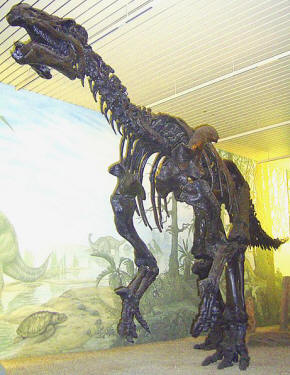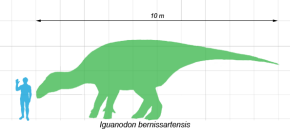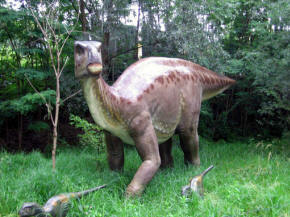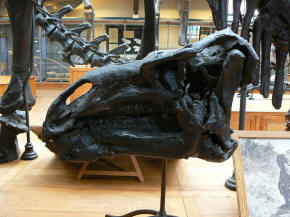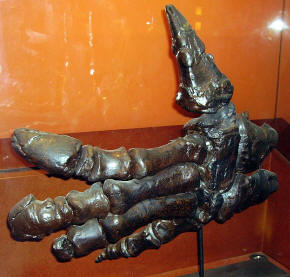|
Discovered in 1822 and described
three years later by English
geologist
Gideon Mantell,
Iguanodon was the second
dinosaur formally named, after
Megalosaurus. Together
with Megalosaurus
and
Hylaeosaurus, it was
one of the three genera originally used to define Dinosauria. A large,
bulky herbivore,
Iguanodon
is a member of Iguanodontia, along
with the duck-billed hadrosaurs.
Description
Iguanodon
was a bulky herbivore that could shift from bipedality to quadrupedality. The best-known species,
I. bernissartensis,
is estimated to have weighed about 3 tonnes (3.5 tons) on average, and
measured about 10 metres long (33 ft) as an adult, with some specimens
possibly as long as 13 metres (43 ft). This genus had a large, tall but
narrow skull, with a toothless beak probably covered
with
keratin, and teeth like
those of an iguana, but much larger
and more closely packed.
The arms were long (up to 75% the
length of the legs in I. bernissartensis)
and robust, with rather inflexible hands built so that the three central
fingers could bear weight. The thumbs were conical spikes that stuck out
away from the three main digits. They could have been
used for defense, or for foraging for food. The little finger was
elongated and dextrous, and could have been used to manipulate objects. The
legs were powerful, but not built for running, and each foot had three toes.
The backbone and tail were supported and stiffened by
ossified
tendons, which were
tendons that turned to bone during life (these rod-like bones are usually
omitted from skeletal mounts and drawings). Overall, in body structure, it
was not too dissimilar from its later relatives, the
hadrosaurids.
Classification and origins
Iguanodon
gives its name to the
unranked
clade
Iguanodontia, a very
populous group of ornithopods with many species known from the Middle Jurassic to the
Late Cretaceous. Aside
from Iguanodon, the
best-known members of the clade include
Dryosaurus,
Camptosaurus,
Ouranosaurus, and the
duck-bills, or
hadrosaurs.
Species
Because
Iguanodon is one of the
first dinosaur genera to have been named, numerous species have been
assigned to it. While never becoming the
wastebasket taxon
several other early genera of dinosaurs became (such as
Megalosaurus and
Pelorosaurus),
Iguanodon has had a
complicated history, and its taxonomy continues to undergo revisions.
Remains of the best-known species have come from Belgium, England, Germany, Spain, and France. Remains of
similar animals possibly belonging to this genus have been found in Tunisia and Mongolia, and a
distinct species is present in Utah, USA. Gregory Paul
has recommended limiting use of
I.
bernissartensis to the Bernissart finds, and
using I. sp.
(meaning undetermined species) for robust iguanodontian remains from Barremian-age rocks of
Europe. Thus, after thorough restudy, what had been seen as a
quintessentially British dinosaur may in fact be poorly known from England.
I. anglicus
was the original
type species, but the
holotype was based on a
single tooth and only partial remains of the species have been recovered
since. In March 2000, the
International Commission on Zoological Nomenclature
changed the type species to the much better known
I. bernissartensis. The
original Iguanodon
tooth is held at
Te Papa Tongarewa, the
national museum of New Zealand in Wellington, although it
is not on display. The fossil arrived in New Zealand following the move of
Gideon Mantell's son Walter there; after the elder Mantell's death, his
fossils went to Walter.
Palaeobiology
Feeding and
diet
One of the first details noted about
Iguanodon was that
it had the teeth of a herbivorous reptile,
although there has not always been consensus on how it ate. As Mantell
noted, the remains he was working with were unlike any modern reptile,
especially in the toothless, scoop-shaped form of the lower jaw
symphysis, which he
found best compared to that of the
two-toed sloth and the
extinct ground sloth
Mylodon.
Iguanodon
teeth are, as the name suggests, like those of an iguana, but larger. Unlike
hadrosaurids, which had
columns of replacement teeth,
Iguanodon
only had one replacement tooth at a time for each position. The upper jaw held up to 29
teeth per side, with none at the front of the jaw, and
the lower jaw 25; the
numbers differ because teeth in the lower jaw are broader than those in the
upper. Because the tooth rows are deeply inset from the outside of the jaws,
and because of other anatomical details, it is believed that, as with most
other ornithischians,
Iguanodon
had some sort of cheek-like structure,
muscular or non-muscular, to retain food in the mouth.
The skull was structured in such a
way that as it closed, the bones holding the teeth in the upper jaw would
bow out. This would cause the lower surfaces of the upper jaw teeth to rub
against the upper surface of the lower jaw's teeth, grinding anything caught
in between and providing an action that is the rough equivalent of mammalian
chewing. Because the
teeth were always replaced, the animal could have used this mechanism
throughout its life, and could eat tough plant material.
Additionally, the front ends of the animal's jaws were toothless and tipped
with bony nodes, both upper and lower, providing a rough margin that was
likely covered and lengthened by a
keratinous material to
form a cropping beak for biting off twigs and shoots. Its food
gathering would have been aided by its flexible little finger, which
could have been used to manipulate objects, unlike the other fingers.
Exactly what
Iguanodon ate with its
well-developed jaws is not known. The size of the larger species, such as
I. bernissartensis,
would have allowed them access to food from ground level to tree
foliage at 4–5 metres
high (13–16.5 ft). Whatever its
exact diet, due to its size and abundance,
Iguanodon is regarded as a dominant medium to
large herbivore for its
ecological communities.
In England, this included the small predator
Aristosuchus, larger
predators
Eotyrannus,
Baryonyx, and
Neovenator,
low-feeding herbivores
Hypsilophodon and
Valdosaurus, fellow
"iguanodontid" Mantellisaurus,
the armoured herbivore
Polacanthus, and
sauropods like
Pelorosaurus.
Posture
and movement
Iguanodon
was initially portrayed as a quadrupedal horn-nosed beast. However, putting the animal in a horizontal
posture makes many aspects of the arms and
pectoral girdle more
understandable. For example, the hand is relatively immobile, with the three
central fingers grouped together, bearing hoof-like
phalanges, and able to
hyperextend. This would
have allowed them to bear weight. The wrist is also
relatively immobile, and the arms and shoulder bones robust. These features
all suggest that the animal spent time on all fours.
Furthermore, it appears that
Iguanodon became more
quadrupedal as it got older and heavier; juvenile
I.
bernissartensis have shorter arms than adults
(60% of hindlimb length versus 70% for adults). When walking as a quadruped,
the animal's hands would have been held so that the
palms faced each other,
as shown by iguanodontian trackways and the anatomy of this genus's arms and
hands. The three toed pes (foot)
of Iguanodon was
relatively long, and when walking, both the hand and the foot would have
been used in a
digitigrade fashion (on
the fingers and toes). The maximum speed of
Iguanodon has been estimated at 24 km/h (14.9 mph), which would have
been as a biped; it would not have been able to gallop as a quadruped.
Thumb spike
The thumb spike is one of the most
well-known features of Iguanodon.
Although it was originally placed on the animal's nose by Mantell, the
complete Bernissart specimens allowed Dollo to correctly place it on the
hand, as a modified thumb. (This would not be the last time a dinosaur's
modified thumb claw would be misinterpreted;
Noasaurus,
Baryonyx, and
Megaraptor are
examples since the 1980s where an enlarged thumb claw was first put on the
foot, as in
dromaeosaurids.)
This thumb is typically interpreted
as a close-quarter
stiletto-like weapon
against predators, although it could also have been used to break into
seeds and fruits, or against
other
Iguanodon.
One author has suggested that the spike was attached to a venom gland, but this
has not been accepted, as the spike was not hollow, nor were there any
grooves on the spike for conducting venom.
In popular
culture
Since its description in 1825,
Iguanodon has been
a feature of worldwide popular culture. Two
lifesize reconstructions of
Iguanodon
built at the Crystal Palace in
London in 1852 greatly contributed to the popularity of the genus. Their
thumb spikes were mistaken for horns, and they were depicted as
elephant-like quadrupeds, yet this was the first time an attempt was made at
constructing full-size dinosaur models.
Several motion pictures have
featured
Iguanodon.
In the Disney film
Dinosaur, an
Iguanodon named Aladar
served as the protagonist with three other iguanodonts as other main
characters; a loosely related ride of the same name
at Disney's Animal Kingdom
is based around bringing an
Iguanodon
back to the present. Iguanodon
is one of the three dinosaur genera that inspired
Godzilla; the other two
were
Tyrannosaurus and
Stegosaurus.
Iguanodon has also made
appearances in some of the many
Land Before Time
films, as well as episodes of the television series.
Aside from appearances on the silver
screen, Iguanodon
has also been featured on the television documentary
miniseries
Walking with Dinosaurs
(1999) produced by the
BBC, and played a starring role in Sir Arthur Conan Doyle's
book,
The Lost World as well
as featuring in an episode of the Discovery Channel
documentary,
Dinosaur Planet. It
also was present in
Bob Bakker's
Raptor Red (1995), as
a
Utahraptor prey item.
A
main belt
asteroid,
1989 CB3,
has been named
9941 Iguanodon in
honour of the genus.
Because it is both one of the first
dinosaurs described and one of the best-known dinosaurs,
Iguanodon has been
well-placed as a
barometer of changing
public and scientific perceptions on dinosaurs. Its reconstructions have
gone through three stages: the
elephantine quadrupedal
horn-snouted reptile of the
Victorians; a bipedal
but still fundamentally reptilian animal using its tail to prop itself up;
and finally, its current, more agile and dynamic representation, able to
shift from two legs to all fours. The second representation dominated the
early 20th century, but was slowly overturned during the 1960s.
Return to the
Old Earth Ministries Online Dinosaur
Curriculum homepage.

Shopping
Bay
State Replicas - Thumb spike, tooth
Black
Hills Institute - none
|
